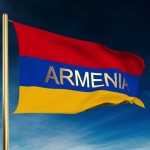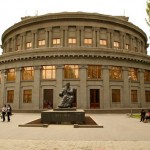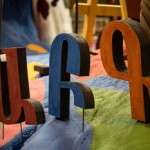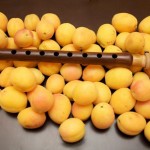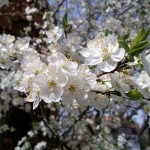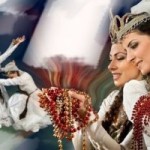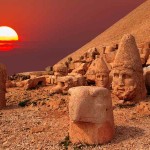
Treasures of Armenia
Comment are off
When hearing the name Armenia, we imagine the first country to have adopted Christianity as a state religion, the Noah’s Ark, the Biblical Mount Ararat and we want to visit Armenia to see those treasures. These are only a few pieces of the treasure called Armenia. Numerous scientific researches and archaeological findings provide evidences that the Armeni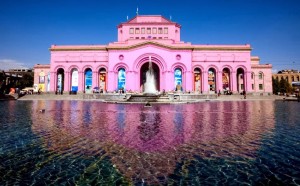 an Highland is the cradle of civilization, embracing a huge amount of mystery. Yerevan- the capital of Armenia is one of the oldest cities in the world and is 29 years older than Rome, with the foundation year in 782 BC. Nowadays, Yerevan is well-known as a Pink city due to the color of the stone used for buildings.
an Highland is the cradle of civilization, embracing a huge amount of mystery. Yerevan- the capital of Armenia is one of the oldest cities in the world and is 29 years older than Rome, with the foundation year in 782 BC. Nowadays, Yerevan is well-known as a Pink city due to the color of the stone used for buildings.
The centre of the city represents a true architectural jewel. However, in the recent years, lamentably some part of the old buildings were destroyed and replaced by the modern ones, transforming the real soul of the city. Despite its developing nature, Armenia is growing as a tourist destination, offering endless natural beauty, numerous cultural heritage sites, rich food and wine traditions and marvels of architecture.
Ararat Mountain
In fact, the most legendary mountain in the world and a major sight of Ararat area – the holy Mount Ararat is located on the territory of Turkey now. Since it is in the western part of Armenia it was left within Ottoman state – only the eastern Armenia was annexed to Russian Empire in the early 20 th century. However, Armenians consider Ararat the symbol of their state no matter what as well as the holy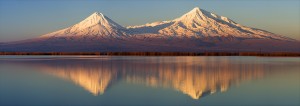 land where Noah moored his Ark. So it would not be a sin to tell a story about Ararat during our trip around the marz named after the holy Mountain. Well, the ancient Ararat stands on the right bank of the Araks near the border with Turkey. Mount Ararat, Armenia it consists of two cones with a common base – the Western or Big Ararat (5,165 m) and the Eastern or Little Ararat (3,925 m). The geological age of the Big Ararat is about 3.5 million years, the little – about 150 thousand years. Armenians lovingly call these tops “two brothers” – Sis and Masis. The tops of these mountains – the former extinct volcanoes – are visible practically from everywhere. The Big Ararat, around which the events described in the Bible developed, is covered by the permanent snow cap under which, probably, the remains of the Noah’s Ark rest. There are about 30 small glaciers the largest of which – St. Jacob – stretches for over two kilometers.
land where Noah moored his Ark. So it would not be a sin to tell a story about Ararat during our trip around the marz named after the holy Mountain. Well, the ancient Ararat stands on the right bank of the Araks near the border with Turkey. Mount Ararat, Armenia it consists of two cones with a common base – the Western or Big Ararat (5,165 m) and the Eastern or Little Ararat (3,925 m). The geological age of the Big Ararat is about 3.5 million years, the little – about 150 thousand years. Armenians lovingly call these tops “two brothers” – Sis and Masis. The tops of these mountains – the former extinct volcanoes – are visible practically from everywhere. The Big Ararat, around which the events described in the Bible developed, is covered by the permanent snow cap under which, probably, the remains of the Noah’s Ark rest. There are about 30 small glaciers the largest of which – St. Jacob – stretches for over two kilometers.
Duduk
The duduk (doo-dook; Armenian: դուդուկ) is an ancient double-reed woodwind flute made of apricot wood. It is indigenous to Armenia. It is commonly played in pairs: while the first player plays the song, the second plays a steady drone, and the sound of the two instruments together creates a richer, more haunting sound. The unflattened reed and cylindrical body produce a sound closer to a clarinet than to more commonly known double-reeds. Unlike other double reed instruments like the oboe or shawm, the duduk has a very large reed proportional to its size.
UNESCO proclaimed the Armenian duduk and i ts music as a Masterpiece of the Intangible Heritage of Humanity in 2005 and inscribed it in 2008. Duduk music has been used in a number of films, most notably in The Russia House and Gladiator. Armenian musicologists cite evidence of the duduk’s use as early as 1200 BC, though Western scholars suggest it is 1,500 years old. Variants of the duduk can be found in Armenia and the Caucasus. The history of the Armenian duduk music is dated to the reign of the Armenian king Tigran the Great, who reigned from 95–55 B.C.According to ethnomusicologist Dr. Jonathan McCollum, the instrument is depicted in numerous Armenian manuscripts of the Middle Ages, and is “actually the only truly Armenian instrument that’s survived through history, and as such is a symbol of Armenian national identity.
ts music as a Masterpiece of the Intangible Heritage of Humanity in 2005 and inscribed it in 2008. Duduk music has been used in a number of films, most notably in The Russia House and Gladiator. Armenian musicologists cite evidence of the duduk’s use as early as 1200 BC, though Western scholars suggest it is 1,500 years old. Variants of the duduk can be found in Armenia and the Caucasus. The history of the Armenian duduk music is dated to the reign of the Armenian king Tigran the Great, who reigned from 95–55 B.C.According to ethnomusicologist Dr. Jonathan McCollum, the instrument is depicted in numerous Armenian manuscripts of the Middle Ages, and is “actually the only truly Armenian instrument that’s survived through history, and as such is a symbol of Armenian national identity.
The most important quality of the duduk is its ability to express the language dialectic and mood of the Armenian language, which is often the most challenging quality to a duduk player.”he sound of the duduk has become known to wider audiences through its use in popular film soundtracks. Starting with Peter Gabriel’s score for Martin Scorsese’s The Last Temptation of Christ, the duduk’s archaic and mournful sound has been employed in a variety of genres to depict such moods. Djivan Gasparyan played the duduk in Gladiator, Syriana, and Blood Diamond, among others. The duduk was also used extensively in Battlestar Galactica.The duduk was also used in the series Avatar: The Last Airbender. Its computer-altered sound was given to the fictitious Tsungi horn, played by a number of the characters. The sound of the duduk was used in The Chronicles of Narnia: The Lion, the Witch and the Wardrobe. A Lullaby that Mr. Tumnus plays on a fictitious double flute.
Apricot
Armenia’s holy land has granted to humanity one of the best and healthy fruits in the world, the apricot. Armenia is the motherland of the Apricot, is the oldest and genuine center for growing apricot. This is 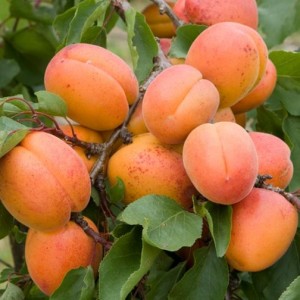 proved by 3000 year old apricot cores discovered during excavations at Garni temple, 25 km far from Yerevan, the capital of Armenia. It is also testified by wide varieties of apricot trees growing in Armenia. The apricot was imported into Europe by Lucullus, a Roman general after the 1st century B.C. Because of its origin the fruit was known as “prunus Armeniaca” which means “Armenian plum”. The Armenian sources are not the only ones to provide information about apricot: in cuneiform inscriptions by Sargon the 2nd of Asorestan (24th century B.C.), we find that he had taken with him plum, apple, mulberry and apricot. In the 2nd and 3rd millenniums B.C. apricot was known to many old nations in the world as “armanu”. Apricot is also remarkable among Armenians because it is from an apricot tree that one of the most beloved and most famous of Armenian national musical instruments, the world acclaimed duduk (in Armenian “tsiranapogh” apricot pipe), is made. There is an interesting fact about apricot: the apricot is similar to the shape of an egg, and the egg, as is well known, is
proved by 3000 year old apricot cores discovered during excavations at Garni temple, 25 km far from Yerevan, the capital of Armenia. It is also testified by wide varieties of apricot trees growing in Armenia. The apricot was imported into Europe by Lucullus, a Roman general after the 1st century B.C. Because of its origin the fruit was known as “prunus Armeniaca” which means “Armenian plum”. The Armenian sources are not the only ones to provide information about apricot: in cuneiform inscriptions by Sargon the 2nd of Asorestan (24th century B.C.), we find that he had taken with him plum, apple, mulberry and apricot. In the 2nd and 3rd millenniums B.C. apricot was known to many old nations in the world as “armanu”. Apricot is also remarkable among Armenians because it is from an apricot tree that one of the most beloved and most famous of Armenian national musical instruments, the world acclaimed duduk (in Armenian “tsiranapogh” apricot pipe), is made. There is an interesting fact about apricot: the apricot is similar to the shape of an egg, and the egg, as is well known, is
the symbol of all existence. The apricot has a unique skin, which preserves the life giving energy, vitamins etc. as well as fabulous taste and smell of apricot for a long time. Armenian apricot is different. No apricot in the world tastes and smells as good as the Armenian apricot. No surprise, that many tourists and especially Diaspora Armenians visit Armenia
during “apricot season”. Following a tradition coming from the depth of centuries, people enjoy this blessed fruit, which protects them from all kinds of diseases. It is told that apricot is one of the exceptional fruits in the world, as it contains gold. The apricot has a very positive influence on human brai n and other organs. It brings people to the condition of golden cut. The “golden cut” is the divine harmony of everything: the positive and negative emotions, feelings, thoughts, abilities, materials and energy. From ancient times apricot is known as “medicine for heart diseases”. It prevents heart attacks; it heals heart diseases as well as many other diseases. Apricot prevents malicious cancer, it improves the immune system, and it activates people and moderates the function of the neural system. The apricot core is also very tasty and useful to health. In Armenia one can often see how children break the core and eat the essence of it. There are numerous opinions and ancient texts according to which, those who periodically eat enough apricot grown on Armenian land: live a long, healthy, and happy life.
n and other organs. It brings people to the condition of golden cut. The “golden cut” is the divine harmony of everything: the positive and negative emotions, feelings, thoughts, abilities, materials and energy. From ancient times apricot is known as “medicine for heart diseases”. It prevents heart attacks; it heals heart diseases as well as many other diseases. Apricot prevents malicious cancer, it improves the immune system, and it activates people and moderates the function of the neural system. The apricot core is also very tasty and useful to health. In Armenia one can often see how children break the core and eat the essence of it. There are numerous opinions and ancient texts according to which, those who periodically eat enough apricot grown on Armenian land: live a long, healthy, and happy life.
Apricot truly is a blessed fruit.
Grape Blessing
Most of us can recall people who would refuse to eat grapes until a priest blessed the fruit. There is a day in the year when people buy the grapes before going to the church because on this special day grapes enter the church as “forbidden fruit” and leave it blessed. This festival is a mixture of celestial and terrestrial, solemnity and familiar ity, tradition and modernity.
ity, tradition and modernity.
In August the Armenian Apostolic Church with great exultation and sublimity is celebrating the feast of the Assumption of the Virgin Mary -The blessing of grapes. It is forth of five major feasts of the Armenian.
Church Calendar and the most ancient- dedicated to St. Mary. Each year on the Sunday closest to the date of August 15, the Armenian Church celebrates the Feast of the Assumption of St. Mary, the Holy Mother of God. In August, since in pagan times, Armenians have been celebrating Navasard with grandeur (New Year holiday), nowadays the feast of Assumption of Holy Virgin celebrated in the same period has particularly inherited some individual features. In August grapes ripen and the festivals of Navasard have been continued with the blessing of grapes. The first blessed harvest was being sacrificed to Goddess Anahit- patroness of fecundity and maternity.
The night before the ceremony pious people abided by their faith come to the church to sing religious songs and sleep inside the sacred walls. In the early morning with the sunrise they were getting ready for the celebration- animal sacrifices, sweets and infinite quantity of fruits accompanied by songs, dances and funny games.
During the grape blessing God is asked for benediction over the grape pits and people enjoy the fruits of it to be mentally and physically healthy and worthy of atonement.
God is asked to bless people who bring the grape as well.
On the Feast of the Assumption of St. Mary, the Ceremony of the Blessing of the Grapes is conducted, and the harvest for the entire year is blessed on that day.
Mary, the Ceremony of the Blessing of the Grapes is conducted, and the harvest for the entire year is blessed on that day.
Grapes do have a certain Christian symbolic significance, but for our ancestors it was a symbol of labor and recreation. Through the blessing, grape got divine significance. Our clergymen had chosen grape for benediction since Christ blessed the wine made from grapes and gave it to his disciples as a symbol of his vital blood. Thus work, pleasure and worship were all brought together in this ceremony. The same blessed grape would become blessed wine, and from that very grape people preserved a bit for the next year grape blessing ceremony as a sign of richness and abundance.
Armenian Brandy (Cognac)
Armenians have kept the record of their brandy since the times of Noah, when the biblical patriarch planted the first vineyard at the foothill s of Mount Ararat. The memory about the forefather of the blessed drink is still alive. Back in the pagan times there was a tradition here of preparing tincture of a thousand herbs – meron (chrism). Even today children are consecrated with meron before christening. One of the wine-makers named Parkev living at the Armenian King Trdats’ court (I c. A.D.) learned to distil spirit from this tincture. In 66 A.D., Trdat left for Rome to the Roman Emperor Nero with a great retinue and luxurious gifts, including chrism. As evidenced by the Roman historians Tacitus, Swetonius and Plinius, tasting meron and rejoicing the consonance of the drink’s name with his own, Nero started charioting on the amphitheatre and headed the feast himself – a rare thing to happen.
s of Mount Ararat. The memory about the forefather of the blessed drink is still alive. Back in the pagan times there was a tradition here of preparing tincture of a thousand herbs – meron (chrism). Even today children are consecrated with meron before christening. One of the wine-makers named Parkev living at the Armenian King Trdats’ court (I c. A.D.) learned to distil spirit from this tincture. In 66 A.D., Trdat left for Rome to the Roman Emperor Nero with a great retinue and luxurious gifts, including chrism. As evidenced by the Roman historians Tacitus, Swetonius and Plinius, tasting meron and rejoicing the consonance of the drink’s name with his own, Nero started charioting on the amphitheatre and headed the feast himself – a rare thing to happen.
During the following couple of days he gave the Armenians so much gold, that it easily compensated their travel and gift expenses. The modern history of Armenian brandy started in 1887, when the first guild merchant Nikolai Tairov (Tairian) built the
first brandy factory in the Russian Empire in the place of the ancient Erivan fortress. The new production lasted until 1899. Nikolai Tairov was unable to settle marketing issues and sold the business to the Russian manufacturer Nikolai Shustov. “Shustov and Sons Company” reconstructed and re-equipped the factory with state-of-the-art technology, purchased distillers, built a new shop for spirit rectification and placed oak barrels in the basement for ageing. Shustov imme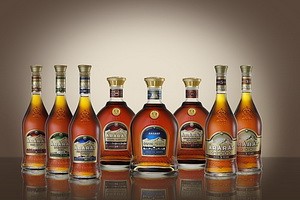 diately started marketing his product. Posters with his logotype – a copper bell and the inscription “Shustov Brandy” – decorated shipboards and dirigibles. The advertising campaign was a success: Shustov’s products secured their place on the Russian market. History holds back whether Shustov was indeed so confident about his brandy or relied on chance when sending bottles of his “brainchild” to a Paris exhibition in 1900. It was a blind tasting and, as if in a fairy tale, the sophisticated French tasters tried the unknown drink and declared it the best awarding it the Grand Prix. The manufacturer’s name caused a lot of sensation: the renowned wine-makers could hardly bear with the foreign production of the originally French brand. As a sign of their respect for quality they allowed Shustov to write “cognac” on his bottles instead of “brandy” – it was customary to call cognac all alcoholic drinks made from grapes, not just those produced in the Cognac province. However, the best recognition for the Armenian production came in 1913 when “Shustov and Sons Company” was honored by becoming the supplier of the Emperor’s court. Only 30 lucky entrepreneurs – both local and international – had similar title. To obtain it, they had to participate in all provincial exhibitions and get not a single reprimand for quality for at least 8 years. After 1917 revolution Shustov’s business was nationalized. His name got lost among thousands of other names and destinies forgotten during 1920’s. Nevertheless, one mention of the Russian manufacturer’s name survived: it was in 1945 when a special 50 degree cognac “Dvin” was produced in Armenia for the Yalta Conference. Sir Winston Churchill asked J. Stalin for a batch of cognac. With a thoughtful look, Stalin answered: “The Soviet Union has full supply of Armenian cognac, so it may as well be sold”. Since then the periodic delivery of “Dvin” to the British Prime Minister had been controlled by the “Father of Nations” personally. In his written
diately started marketing his product. Posters with his logotype – a copper bell and the inscription “Shustov Brandy” – decorated shipboards and dirigibles. The advertising campaign was a success: Shustov’s products secured their place on the Russian market. History holds back whether Shustov was indeed so confident about his brandy or relied on chance when sending bottles of his “brainchild” to a Paris exhibition in 1900. It was a blind tasting and, as if in a fairy tale, the sophisticated French tasters tried the unknown drink and declared it the best awarding it the Grand Prix. The manufacturer’s name caused a lot of sensation: the renowned wine-makers could hardly bear with the foreign production of the originally French brand. As a sign of their respect for quality they allowed Shustov to write “cognac” on his bottles instead of “brandy” – it was customary to call cognac all alcoholic drinks made from grapes, not just those produced in the Cognac province. However, the best recognition for the Armenian production came in 1913 when “Shustov and Sons Company” was honored by becoming the supplier of the Emperor’s court. Only 30 lucky entrepreneurs – both local and international – had similar title. To obtain it, they had to participate in all provincial exhibitions and get not a single reprimand for quality for at least 8 years. After 1917 revolution Shustov’s business was nationalized. His name got lost among thousands of other names and destinies forgotten during 1920’s. Nevertheless, one mention of the Russian manufacturer’s name survived: it was in 1945 when a special 50 degree cognac “Dvin” was produced in Armenia for the Yalta Conference. Sir Winston Churchill asked J. Stalin for a batch of cognac. With a thoughtful look, Stalin answered: “The Soviet Union has full supply of Armenian cognac, so it may as well be sold”. Since then the periodic delivery of “Dvin” to the British Prime Minister had been controlled by the “Father of Nations” personally. In his written  requests for subsequent batches Churchill persistently called the cognac by Shustov’s name, while the Russian side patiently corrected:”formerShustov’s cognac”. The legal delivery to England continued until the beginning of the cold war. Afterwards, the Russians refused to supply Churchill with that dainty. However, Churchill’s passion for cognac turned out to be stronger than his political ambitions. Only God knows how he continued receiving his favorite drink. And when aged Churchill was asked about the secret of his longevity, he answered without hesitation: “Never be late for dinner, smoke Hawaiian cigars and drink Armenian cognac!”
requests for subsequent batches Churchill persistently called the cognac by Shustov’s name, while the Russian side patiently corrected:”formerShustov’s cognac”. The legal delivery to England continued until the beginning of the cold war. Afterwards, the Russians refused to supply Churchill with that dainty. However, Churchill’s passion for cognac turned out to be stronger than his political ambitions. Only God knows how he continued receiving his favorite drink. And when aged Churchill was asked about the secret of his longevity, he answered without hesitation: “Never be late for dinner, smoke Hawaiian cigars and drink Armenian cognac!”
Khachkar
Each culture possesses a certain original element which becomes a symbol of the entire national culture. In Armenia such symbol is “khachkar”, the so-called crosses-stones, the monuments of Armenia which are not found anywhere in the world. The word “khachkar” is formed by two Armenian roots: “khach” (cross) and “kar” (stone).
Khachkar is an art – decorative-architectural sculptures based on the ancient national traditions and made in a variety of shapes. Khachkars originated in the beginning of the 4 th century right after the adoption of Christianity. Instead of th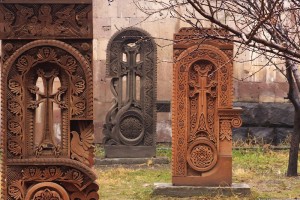 e pagan altars and in the places allocated for churches and monasteries wooden crosses were installed. Since wood was not durable, they were replaced by stone ones, and starting from the 9 th century with the images of crosses on stone rectangular slabs. At the same time khachkars were installed on various occasions: to commemorate a victory or completion of another temple or bridge, to thank God for a plot of land. They served as landmarks and very frequently as sepulchral monuments.The central symbol of any khachkar was a new-born, growing like a tree or a flower, cross – the Khachkars symbol of new eternal life. Under the cross they cut a circle: the circle with the cross on it symbolized celebration of Christian faith. Above the cross they usually placed common Christian faiths symbols of four evangelists – an eagle, a lion, a bull and an angel. For Armenians they were four beginnings of the universe – fire, water, earth and air. The stone-cutters who made khachkars were called varpets. Their art is alive and is in demand even now. Khachkars keep the spirit of Armenian people, the entire divinity of Armenian Apostolic Church. The biggest cemetery with ancient khachkars in Armenia is near the settlement of Noraduz. A millennium of Armenian history is embodied in the khachkars there; the most ancient stones are dated the 8 th century.
e pagan altars and in the places allocated for churches and monasteries wooden crosses were installed. Since wood was not durable, they were replaced by stone ones, and starting from the 9 th century with the images of crosses on stone rectangular slabs. At the same time khachkars were installed on various occasions: to commemorate a victory or completion of another temple or bridge, to thank God for a plot of land. They served as landmarks and very frequently as sepulchral monuments.The central symbol of any khachkar was a new-born, growing like a tree or a flower, cross – the Khachkars symbol of new eternal life. Under the cross they cut a circle: the circle with the cross on it symbolized celebration of Christian faith. Above the cross they usually placed common Christian faiths symbols of four evangelists – an eagle, a lion, a bull and an angel. For Armenians they were four beginnings of the universe – fire, water, earth and air. The stone-cutters who made khachkars were called varpets. Their art is alive and is in demand even now. Khachkars keep the spirit of Armenian people, the entire divinity of Armenian Apostolic Church. The biggest cemetery with ancient khachkars in Armenia is near the settlement of Noraduz. A millennium of Armenian history is embodied in the khachkars there; the most ancient stones are dated the 8 th century.
Alphabet
One of the most important events in the history of Armenia happened in 405 AD, when the new Armenian alphabet was created. Before that, for about 16 hundred years, various forms of cuneiforms had been used in Armenia. After the adoption of Christianity as the state 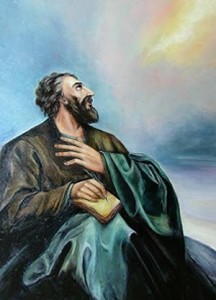 religion of Armenia in 301 AD, the Church regarded the old systems of writing as inappropriate for religious use. An attempt was made to use the Greek and Syriac languages as the official languages of the Church and the state, but this was rejected after several decades, mainly because the ordinary people did not understand those languages, which made the spread of the new religion more difficult, and also because of the resistance of the nationalistically minded aristocracy and bureaucracy. At the end of the IV century there were several attempts to adjust the old systems of writing to the needs of the Church, but they all failed, because the proposed versions did not reflect correctly the phonetic system of the language. In the nineties of the century king Vramshapuh asked a high-ranking official in his chancellery and a prominent scholar Mesrop Mashtots to make another attempt. Mesrop Mashtots travelled to Alexandria, then the biggest cultural and scientific centre of the world, and studied there various principles of writing. He came to the conclusion that the Greek alphabet was the most advanced one of that time since it had one letter for each sound and was easy to memorise and to use. So he created an alphabet which followed the principle of ‘one letter for one sound’ and was written from left to right and had capital letters, unlike all other languages of Eastern Anatolia and the Middle East, which were mostly written from right to left and had no capitals.
religion of Armenia in 301 AD, the Church regarded the old systems of writing as inappropriate for religious use. An attempt was made to use the Greek and Syriac languages as the official languages of the Church and the state, but this was rejected after several decades, mainly because the ordinary people did not understand those languages, which made the spread of the new religion more difficult, and also because of the resistance of the nationalistically minded aristocracy and bureaucracy. At the end of the IV century there were several attempts to adjust the old systems of writing to the needs of the Church, but they all failed, because the proposed versions did not reflect correctly the phonetic system of the language. In the nineties of the century king Vramshapuh asked a high-ranking official in his chancellery and a prominent scholar Mesrop Mashtots to make another attempt. Mesrop Mashtots travelled to Alexandria, then the biggest cultural and scientific centre of the world, and studied there various principles of writing. He came to the conclusion that the Greek alphabet was the most advanced one of that time since it had one letter for each sound and was easy to memorise and to use. So he created an alphabet which followed the principle of ‘one letter for one sound’ and was written from left to right and had capital letters, unlike all other languages of Eastern Anatolia and the Middle East, which were mostly written from right to left and had no capitals.
In 405 Mesrop Mashtots returned to Armenia, bringing with him the 36 new letters of the Armenian alphabet. The same year the Bible was translated anew and re-written in the new alphabet. The Armenian translation of the Bible, whic h contains more words than the Hebrew and Greek originals, was so perfect that it soon came to be known as the ‘Queen of Translations’. The new alphabet stimulated an unprecedented boom in literature, and the V century was later called the ‘Golden Age of Armenian Literature’.
h contains more words than the Hebrew and Greek originals, was so perfect that it soon came to be known as the ‘Queen of Translations’. The new alphabet stimulated an unprecedented boom in literature, and the V century was later called the ‘Golden Age of Armenian Literature’.
The first words written in Armenian were as follows:
“to learn wisdom and exhortation, to understand sayings of reason.”
The alphabet created by Mesrop Mashtots was so perfect that it has not been changed or reformed since 405 AD. The letters used today look exactly as Mesrop Mashtots created them. The Armenian alphabet played an enormous role in the preserving of the national and cultural identity of the Armenian people, and enjoys a very special love and respect. For the creation of the alphabet Mesrop Mashtots was later canonized by the Armenian Apostolic Church.
Matenadaran
At the upper end of Mashtots Avenue, is Matenadaran, with its solemn facade facing Ararat. Impressing statues of Mashtots, the creator of Armenian Alphabet and other eminent Armenians; Korun, Gosh, Shirakatsi, Tatevatsi etc. are erected in front of Matenadaran.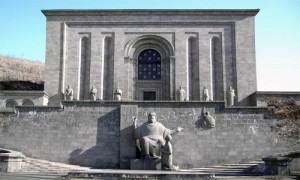 Matenadaran, which was built in 1959, has one of the world’s largest manuscript collections in the world and has the largest collection of Armenian manuscripts. It has over 17 000 units which include numerous fragments from Armenian and foreign ancient manuscripts, complete parchments, copies of first printed books etc. The oldest manuscript, that has been preserved completely, is the Vehamor (Our Lady) Gospel written in the 7th century. Some of the most impressing items in Matenadaran are the Msho Charentir, the largest manuscript that weighs over 27 kilos and the tiny church calendar of 1434 which not bigger than a passport photo and which weighs only 19 grams.
Matenadaran, which was built in 1959, has one of the world’s largest manuscript collections in the world and has the largest collection of Armenian manuscripts. It has over 17 000 units which include numerous fragments from Armenian and foreign ancient manuscripts, complete parchments, copies of first printed books etc. The oldest manuscript, that has been preserved completely, is the Vehamor (Our Lady) Gospel written in the 7th century. Some of the most impressing items in Matenadaran are the Msho Charentir, the largest manuscript that weighs over 27 kilos and the tiny church calendar of 1434 which not bigger than a passport photo and which weighs only 19 grams. 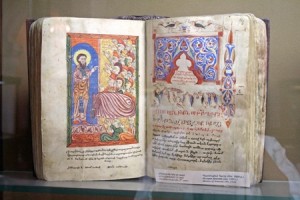 Many manuscripts with Armenian miniature done with Armenian Red, a magnificent dyestuff discovered in ancient Armenia are exhibited in Matenadaran. This special paint was first documented to exist in 714 B.C. and was made from worms peculiar only to Ararat plain. The Armenian Cochineal was used in rugs and in miniatures, which maintain their vivid color even after centuries.
Many manuscripts with Armenian miniature done with Armenian Red, a magnificent dyestuff discovered in ancient Armenia are exhibited in Matenadaran. This special paint was first documented to exist in 714 B.C. and was made from worms peculiar only to Ararat plain. The Armenian Cochineal was used in rugs and in miniatures, which maintain their vivid color even after centuries.
Matenadaran is not only a museum, but a major research center. There is a large library functioning adjacent to Matenadaran, which is truly the most important scientific center for Armenian studies. Even a very short visit to Matenadaran, (Shelf for Parchments) will reveal the vital role the Armenian language and the Armenian Alphabet have played in world culture.
Famous Armenians
Many famous singers and movie stars, politicians and public figures, scientists and artists, whose talent is acknowledged in the whole world, have an Armenian origin.
French singer, composer, public figure, French music hall star, award-winner of the Cannes Festival, benefactor with his own benevolent fund, permanent ambassador of UNESCO, Charles Aznavour, whose real name is Vaghinak Aznavuryan.
Famous composer Aram Khachaturyan, creator of the Second Symphony, “Gayane” and “Spartak” ballets, and many other compositions that brought him a world fame
USSR Marshal and twice a Soviet Union Hero Hovhannes Baghramyan
Soviet politician Anastas Mikoyan, chairman of the Council of Ministers of the USSR, played a significant role in prevention of the Third World War during Khrushchev’s times.
Michel Legrand (born February 24, 1932 in Paris) is a French musical composer, arranger, conductor and pianist. He has composed over 200 film and television scores, several musicals, and made well over a hundred albums. He has won three Oscars, five Grammys, and has been nominated for an Emmy.
System of a Down (also known as SOAD) is a four-piece, Grammy-award winning band, formed in 1995 in Los Angeles, California. All four members are of Armenian descent, grandsons of Armenian Genocide survivors, and are widely known for their outspoken views found in many of their songs.
Tigran Petrosyan was a former World Chess Champion. He was nicknamed “Iron Tigran” due to his playing style because of his almost impenetrable defense, which emphasized safety above all else.
Cher (Cheryl Sarkisian LaPierre) is an American actress, singer, songwriter, author and entertainer. Among her many accomplishments in music, television, and film, she has won an Academy Award, a Grammy Award, an Emmy Award and three Golden Globe Awards.
Rouben Mamoulian was an Armenian-American film and theatre director.
Alan Hovhaness was an American composer of Armenian and Scottish descent. His music is accessible to the lay listener and often evokes a mood of mystery or contemplation. He was among the most prolific composers of the 20th century, composing 67 symphonies and more than 400 opus numbers.
Arto Tunçboyacıyan a famous avant-garde folk artist (singer, multi-instrumentalist), he appeared on more than 200 records in Europe before arriving in the United States, where he went to work with numerous jazz legends including Chet Baker, Al Di Meola and Joe Zawinul. Arto fronts his own group called the Armenian Navy Band (ANB).
Armen Dzigarkhanyan is one of the most popular Armenian actors working in Russia. He starred in dozens of Soviet films and provided the voice for many cartoon characters. He founded his own theater in Moscow.
Arshile Gorky (Vostanik Manoog Adoyan) was an Armenian American painter who has a seminal influence on Abstract Expressionism. Gorky left Van in 1915 during the Armenian Genocide and was reunited with his father when he arrived in America in 1920. He changed his name to Arshile Gorky, in the process reinventing his identity.
Gregory Peck was born in La Jolla, California. He enrolled in the Neighborhood Playhouse in New York and debuted on Broadway after graduation. His debut was in Emlyn Williams’ stage play “The Morning Star” (1942). By 1943, he was in Hollywood where he debuted in the RKO film Days of Glory (1944). He worked with Audrey Hepburn in her debut film, Roman holiday (1953). In the early 70s, he produced two movies, The Trial of the Catonsville Nine (1972) and The Dove (1974), while his film career waned.
William Saroyan was an American author who wrote many plays and short stories about growing up impoverished as the son of Armenian immigrants. These stories were popular during the Great Depression. Saroyan grew up in Fresno, the center of Armenian-Americans in California, where many of his works are set.
Ivan Aivazovsky was a Russian painter of Armenian descent, most famous for his seascapes, which constitute more than half of his paintings. Due to his long life in art, Aivazovsky became the most prolific Russian painter of his days. He left over 6,000 works at his death in 1900. With funds earned during his successful career as an artist he opened an art school and gallery in his home town of Feodosiya.
Kirk Kerkorian is an American billionaire, and president/CEO of Tracinda Corporation, his private holding company based in Beverly Hills, California. Kerkorian is known as one of the important figures in shaping the city of Las Vegas, Nevada. Kerkorian splits his time between his residences in Beverly Hills and Nevada.
Atom Egoyan is a critically acclaimed Canadian-Armenian film maker. His work often explores themes of alienation and isolation, featuring characters whose interactions are mediated through technology, bureaucracy or other power structures.
Henri Verneuil was a prominent French playwright and filmmaker. He recounted his childhood experience in the novel “Mayrig”, which he dedicated to his mother and made into a 1991 film with the same name, which was followed by a sequel, 588 Rue Paradis, the following year.
Karen Shakhnazarov is a Russian filmmaker, producer and screenwriter. He became the Director General of the Mosfilm studios in 1998.Shakhnazarov is the son of a prominent politician of Armenian descent, Georgy Shakhnazarov. Since 2005 he has been a member of the Public Chamber of Russia.
Djivan Gasparyan is an Armenian musician and composer. He plays the duduk, an Armenian double reed woodwind instrument related to the orchestral oboe. He has won four world-wide gold Medal UNESCO competitions (1959, 1962, 1973, and 1980). In 2002, he received the WOMEX (World Music Expo) lifetime achievement award. He has toured the world several times with a small ensemble playing Armenian folk music. He has collaborated with many artists, such as Hossein Alizadeh, Sting, Erkan Ogur, Michael Brook, Peter Gabriel, Brian May, Lionel Richie, Derek Sherinian, Ludovico Einaudi, and Hans Zimmer. Djivan Gasparyan and Hossein Alizadeh were jointly nominated for a 2007 Grammy award for their 2006 collaboration album Endless Vision.
Andre Agassi is a former World No. 1 professional tennis player from the United States who won eight Grand Slam singles tournaments and an Olympic gold medal in singles. He is one of only five male players to have won all four Grand Slam singles events during his career. He is the only player in the open era to have won every Grand Slam singles title, to have won the Tennis Masters Cup, to have been part of a winning Davis Cup team, and to have won an Olympic gold medal. He won 17 ATP Masters Series tournaments, more than any other player. TENNIS Magazine has named him the 7th greatest male player from 1965 through 2005.
Sergey Parajanov is considered by many to be one of the most original and critically-acclaimed filmmakers of the 20th century. His work reflected the ethnic diversity of the Caucasus where he was raised. In 1964 he directed “Shadows of Forgotten Ancestors”, which won numerous international awards including the prestigious BAFTA award given by the British Academy of Film and Television Arts.
Alex Manoogian was a successful American businessman, industrial engineer, and well-known philanthropist, especially to Armenian causes.
Gerard Cafesjian is an American businessman of Armenian descent and philanthropist who founded the Cafesjian Family Foundation and has contributed thousands of dollars to numerous philanthropic causes, including contributing funds toward buying an Armenian Genocide Museum and Memorial Museum in Washington D. C., and building a Cultural and Art Museum in Yerevan
Alain Prost The four-time Formula One drivers’ champion held the record for most grand prix victories from 1987 until 2001, when he was beaten by Michael Schumacher. The 60-year-old French racing driver’s maternal grandparents are Armenian. His grandmother fled from the genocide to France, where she met her husband and gave birth to Marie-Rose Karatchian, Prost’s mother.
Andy Serkis The 50-year-old actor is most famous for playing Gollum in The Lord of the Rings and The Hobbit. Serkis, who also starred as King Kong in Peter Jackson’s remake of the film and as Caesar in Rise of the Planet of the Apes and its sequel, was born to a British mother and Armenian father. His father’s family’s original surname was Sarkisian, which an ancestor changed to Serkis.
David Dickinson The 73-year-old British antiques dealer and television presenter was born to an Armenian mother, Eugene Gulessarian, and then adopted as a baby by Jim and Joyce Dickinson. The host of Dickinson’s Real Deal and Bargain Hunt did not know he was adopted until he was 12 and never met his biological mother, though they corresponded until her death. In 2006, Dickinson participated in the BBC’s Who Do you Think you Are? which led him to travel to Turkey, where his Armenian ancestors lived before they moved to Britain.
Sergei Lavrov Russia’s foreign minister since 2004, Lavrov was previously Russia’s ambassador to the United Nations for a decade. The 65-year-old was born in Moscow to an Armenian father and a Russian mother and has been quoted as saying: “I have Armenian blood in my veins.”
Kim Kardashian The 34-year-old reality television star and professional selfie-taker (a book of her selfies is released next month) is one of Armenia’s most famous descendants. Kardashian (officially Kardashian West, since she married the hip-hop star Kanye West) visit Armenia, the ancestral home of her late father, Robert, and laid flowers at the Armenian genocide memorial complex. Not one to make her cultural pilgrimages in secret, the trip was filmed for Keeping Up with the Kardashians, the family’s reality show. The visit Armenia has been praised for raising awareness of the anniversary of the genocide, something that Kardashian draws attention to each year. Her father was a defense lawyer in OJ Simpson’s 1995 murder trial.
They are loved and remembered, people are proud of them, admire them, and name streets in their honor, build monuments and museums.

